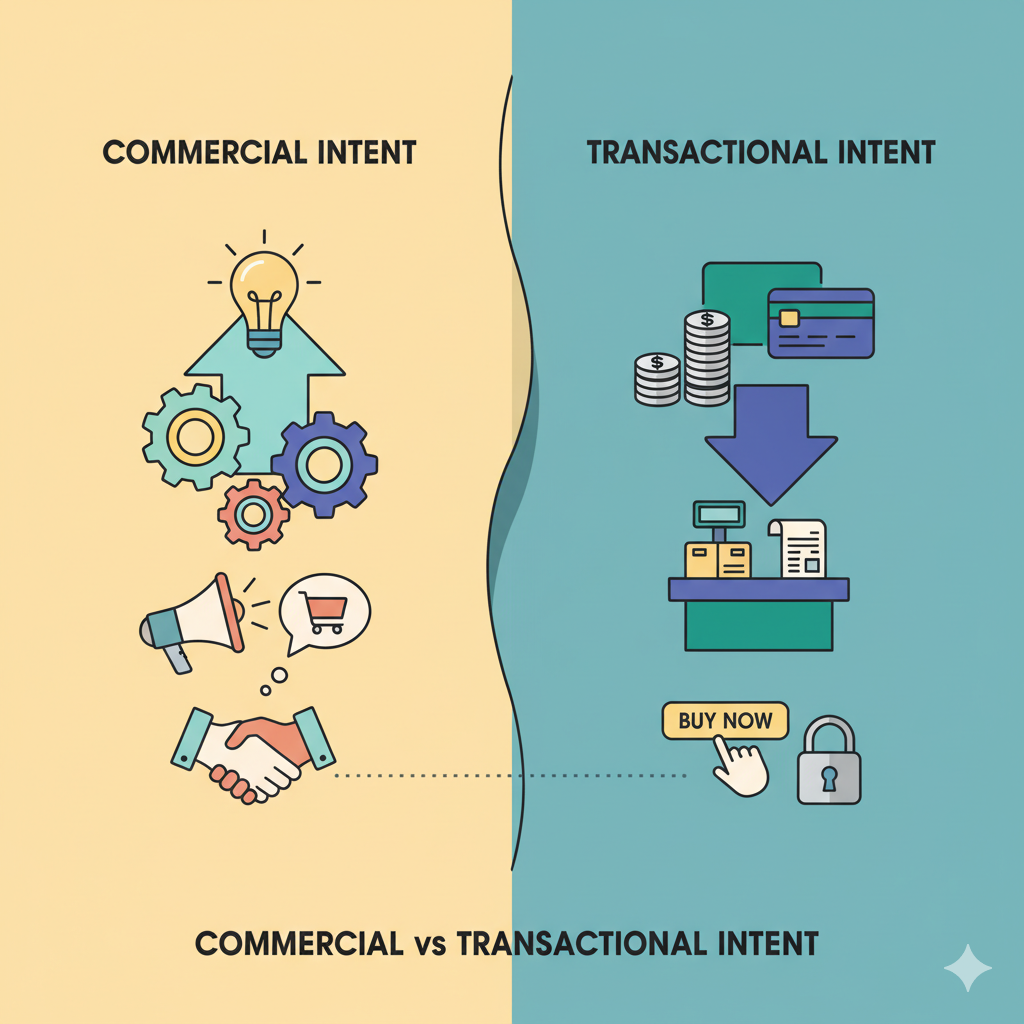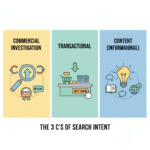When it comes to SEO, not all searches are created equal. Some people are just browsing, some are comparing options, and some are ready to hit the “buy now” button. Understanding this difference is what separates a decent SEO strategy from a revenue-generating one.
Two of the most important types of search intent are commercial intent and transactional intent. They might sound similar, but in reality, they represent different stages of the buyer’s journey and if you mix them up, you’ll either miss out on conversions or fail to attract the right traffic.
In this article, we’ll break down:
- What commercial intent means
- What transactional intent means
- The key differences between them
- Why both matter for SEO and marketing
- How to target each effectively with content and keywords
- Real-world examples you can learn from
What is Commercial Intent?
Commercial intent refers to searches made by people who are in the research and consideration stage. They are interested in a product or service, but they are not yet ready to make the final purchase decision.
Think of it as the “window-shopping phase” of the customer journey.
Examples of Commercial Intent Keywords
- “Best laptops under £1,000”
- “iPhone vs Samsung comparison”
- “Top digital marketing agencies UK”
- “Best CRM software for small business”
Here, the searcher:
- Knows they need a product or service.
- Is comparing features, reviews, and alternatives.
- Wants to narrow down choices before buying.
They’re gathering information that will influence their decision.
What is Transactional Intent?
Transactional intent refers to searches made by people who are ready to take action usually making a purchase, booking a service, or signing up.
Think of it as the “I have my card in hand” phase of the journey.
Examples of Transactional Intent Keywords
- “Buy iPhone 15 online”
- “Order pizza near me”
- “Book dentist appointment London”
- “Subscribe to Netflix plan”
Here, the searcher:
- Already knows what they want.
- Is looking for the quickest way to complete the transaction.
- Usually uses words like buy, order, book, subscribe, download.
This is where the money lies people are literally telling you they’re ready to convert.
Commercial vs Transactional Intent: The Key Differences
To make it clearer, let’s put both side by side:
| Aspect | Commercial Intent | Transactional Intent |
|---|---|---|
| Stage in journey | Consideration stage | Decision/action stage |
| Goal | Compare, research, shortlist | Purchase, sign up, book |
| Keywords | best, top, review, vs, alternatives | buy, order, subscribe, download |
| Content type | Blogs, comparisons, case studies, guides | Product pages, service pages, checkout flows |
| Traffic value | High traffic, builds trust | Lower traffic volume, but high conversions |
| User mindset | Curious, exploring | Ready, decisive |
This chart highlights the clear difference between commercial and transactional intent. With commercial intent, users are still exploring their options they’re comparing, reading reviews, or searching for the “best” choice. Content like blogs, guides, and comparisons works well here because it helps build trust and positions your brand as a helpful resource. While this stage brings in higher traffic, it doesn’t always convert immediately.
On the other hand, transactional intent shows that users are ready to take action. Their searches often include terms like buy, order, or subscribe, and the best response is to give them direct product or service pages with a smooth path to conversion. Although transactional searches bring in less traffic, they’re far more valuable because these visitors are decisive and more likely to convert into paying customers.
Why Understanding Intent Matters
If you target transactional keywords with commercial content (or vice versa), you’ll frustrate users and lose conversions.
For example:
- If someone searches “best running shoes for beginners” and lands on a checkout page, they’ll bounce they weren’t ready to buy yet.
- If someone searches “buy Nike Air Zoom UK” and lands on a 2000-word blog, they’ll leave they wanted a purchase button.
By aligning content with intent, you:
- Match user expectations.
- Reduce bounce rates.
- Improve conversions.
- Build trust at the right stage.
How to Optimise for Commercial Intent
Commercial intent keywords are about helping people choose. To target them:
- Write comparison content
Example: “Shopify vs WordPress: Which is Better for Your Online Store?” - Create listicles and guides
Example: “Top 10 Budget-Friendly Smartphones in 2025” - Use detailed reviews and case studies
Share real experiences to build trust. - Focus on long-tail keywords
Example: “Best project management tool for freelancers” - Optimise for featured snippets
Since users are asking questions, structure answers clearly.
This content should educate and guide, not push for an immediate sale.
How to Optimise for Transactional Intent
Transactional intent is where you need clear, frictionless conversion paths. To target it:
- Optimise product/service pages
- Clear CTAs like “Buy Now”, “Order Today”.
- Trust signals: reviews, guarantees, secure checkout.
- Target action-based keywords
Example: “Buy MacBook Air M3 online UK”. - Use structured data
Add schema for products, reviews, and pricing so Google shows rich snippets. - Minimise distractions
A transactional page should focus only on completing the action, not long explanations. - Mobile-first design
Many transactional searches (like “order food near me”) happen on mobile. Speed and UX are critical.
How Commercial and Transactional Intent Work Together
The best SEO strategies don’t pick one they balance both.
Think of commercial intent as warming up leads, and transactional intent as closing the sale.
- Commercial content drives awareness and builds trust.
- Transactional content captures users when they’re ready to buy.
- Together, they create a smooth funnel from research → consideration → purchase.
Example funnel:
- Blog: “Best DSLR Cameras for Beginners in 2025” (commercial).
- Comparison: “Canon EOS vs Nikon D5600: Which One Wins?” (commercial).
- Product page: “Buy Canon EOS 250D with Free Shipping UK” (transactional).
By covering both intents, you guide the same user from curiosity to conversion.
Commercial vs Transactional Intent Examples
- Amazon
- Commercial content: Product comparison pages and Q&A sections.
- Transactional content: Product listing with “Buy Now”.
- SaaS Companies (like HubSpot)
- Commercial content: Blog posts like “Best CRM Tools for Small Businesses”.
- Transactional content: Product pages with “Start Free Trial”.
- Local Businesses
- Commercial: “Top dentists in London reviews”.
- Transactional: “Book dentist appointment online London”.
Conclusion
The difference between commercial vs transactional intent is simple but powerful:
- Commercial intent = People are researching.
- Transactional intent = People are ready to act.
Both are essential in content marketing and SEO. One builds trust, the other drives sales. When you map keywords and content correctly to each stage, you’ll not only get traffic you’ll convert it into paying customers.
So, the next time you’re planning content or doing keyword research, ask yourself:
- Is my audience still deciding (commercial)?
- Or are they ready to buy (transactional)?
Get this right, and your SEO strategy will go from just bringing traffic to actually bringing revenue.
Discover more from PratsDigital
Subscribe to get the latest posts sent to your email.


